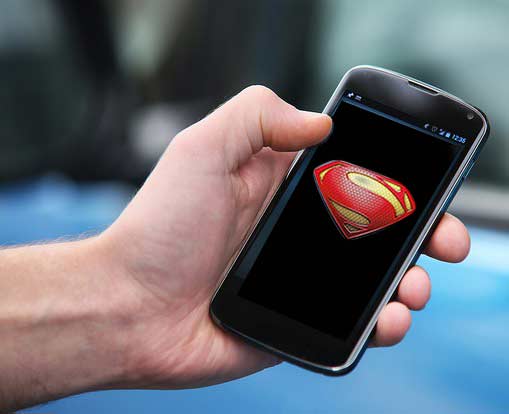
I’m sure you guys are getting tired of my whining about how the current crop of smartphones isn’t as “fun” as devices were back in the good old days of PDAs when new features and technology was being developed every few months. I even get tired of listening to myself because I’m starting to remind myself of SNL’s Grumpy Old Man. “…in my day, we used plastic toothpicks to type on black and white screens, and that’s the way it was, and we LIKED it!” 🙂
It’s time (for me) to stop looking backward and start looking forwards. Each new phone model that Apple, Google, LG, Motorola, etc. releases might not be exciting right now, but what comes next?
Today mobile phones are also known as smartphones. What will we be calling them five years from now? I’m going to get a jump on the name game and I’m going to say that they’ll be called superphones.
In my superphone dreams (you dream about gadgets too right?), I envision a handheld device similar to what we have now, but this device will be our main computing, communication, life logging and entertainment device. A one device to rule them all kind of device.
Here are the features I want to see in a superphone in the five years:
- Completely waterproof – this is not a stretch now since Apple and Samsung are leading the way now with this feature
- Battery life that lasts at a minimum of 48hrs without needing to be recharged even when playing movies
- Hyperfast recharging wirelessly or via a cable. Fully recharged in 15 minutes or less
- 5.5 inch display when in handheld phone mode, but display unfolds to 11 inch for tablet mode
- Snap on keyboard with touchpad that’s as good as MacBook touchpads that turns the phone into a laptop that can be actually be used on your lap
- An operating system robust enough that it will allow this one device to be a full fledged computer that I can use for all my work including photoshop, video editing, etc.
You know after writing down the features that I want to have in a superphone, I see that I really don’t want as much as I thought I did. What I want most is really long battery life and just one device that’s my phone, my computer and my camera while still fitting in my pocket. I’m sure that’s going to happen. I already see it happening. I am just anxious for it to hurry the heck up and get here so I can buy one and then complain about the features it doesn’t have 😉
What about you? What would be your dream device?




Gadgeteer Comment Policy - Please read before commenting
I want to be able to configure it before I buy it – like my car. I don’t want a camera on either front or back, I don’t want force touch or contactless capability and I don’t need it to be waterproof. I don’t need a retina screen – the iPhone 3G resolution would be fine for me. I’d like to delete some or all of these functions and select options like more battery, more memory or a memory card slot or dual SIM or better phone sensitivity or a connector of my choosing so I don’t have to bin £100s of accessories or an integrated car-mount kit or a different form factor or ………..etc. All this using an online configurator (like with a car) and delivered 24 hours later.
That way I get to choose the OS that I prefer and I don’t have to spend money on useless (to me) functionality.
Love those ideas, especially the ability to choose the OS. I’d like the iPhone 7 Plus, but with the Android OS 😉 Or in a perfect world, I want the iPhone 7 Plus but with Mac OS!
1. Easy pairing with all types of peripherals.
2. I have lots of music and especially photos that I want to keep, but I don’t want to have either on my phone or in the cloud. Where and how I store data should be up to me, not the phone company.
2. Pair a large monitor quickly and easily. And a standard keyboard and mouse.
3. Perhaps multiple switchable OSs and environments. When I’m at work I will be using the work OS and environment. When at home my home environment. And if my employer permits I can be at home and log in and switch to the work environment.
It would be nice to have a screen that’s exactly the same size of the case (so no edges!).
For me it would be wonderful to have it run under full Windows, but then with all the apps that are available for Android and iOS.
Your ideas plus wall screen projection and a laser projected keyboard. Without much dropoff in battery life, of course. One can dream, can’t we?
Would you really use a laser keyboard? I’ve tried them and they aren’t great… at least not if you’re already a fast touch typist.
Add the ultimate peripheral…
https://www.kickstarter.com/projects/sgnlstrap/sgnl-make-phone-calls-with-your-fingertip?ref=nav_search
I want to split the CPU and radios from the screen. I’d have a box I could clip to a belt, put in a pocket or purse, or set on my desk. It would connect to a phone sized, tablet sized, or desktop sized screen via Miracast. It would have two SSD drives set up for mirrored RAID.
The screens would support Wacom pen input in addition to touch and have stereo speakers, a noise cancelling microphone, and a front facing camera with the phone sized screen offering a rotating camera for photography.
Everything would have wireless charging. The CPU module would have a dock with a keyboard (with a track stick) and USB, HDMI, and possibly other ports. The tablet screen would have an attachable keyboard (also with a track stick – I really hate touchpads).
The whole shebang would run Windows 10 (until Google beefs up Chrome OS or Apple moves MacOS into the 21st century).
My Amex is waiting.
I love my iPhone 7 Plus. It’s incredible what this thing does. Yet at times I pine for my old Sony Clie TH-55. In some ways it was more useful than the most advanced smartphones we have today. I can go with a PDA-style stylus a la the Galaxy Note (yet less flamey) housed in the body of the device, MUCH better battery life and the ability to run less crippled versions of desktop apps. I would also like to see clamshell keyboard cases made available to turn my smartphone into a 21st century version of the HP 200LX that I still have (and that still works).
A phablet just like the Nexus 6 but with updated specs and a one inch larger screen.
Your ideas are great and they would certainly make things more fun at your invitation I would like to take a stab at predicting future of superphones.
As smartphone technology space matured we shifted focus away from new use cases to well-established ones thereby improving performance, reducing the size and improving fit, finish, and usability at cost of new experimentation and in some cases capabilities.
If I would look that far ahead to superphone I am going to stretch things to say the convergence of personal devices into our own ecosystem backed by multiple platforms where private data is equally accessible to any authorized device. The phone is key to the secure ecosystem.
I propose there are 4 major classes of devices meeting somewhat overlapping user in this personal ecosystem:
1) Super users who grew up on PCs wanting high compute , hungry productivity applications and real OS feel with shells providing the high level of personalization, customization, and control. 2) Streamlined users who just want simplicity, minimalism and willing to give up control for ease of use like tablets of today.
3) Specialized Gaming Machine /Smart TVs / Virtual Reality.
4)Sensor devices that just act as real world point of presence like health monitors, Amazon Echo to IOT like thermostats.
Today phones scale up and down across the specturm of these use cases and or integrate with other smarter or dumber devices. We are just restricted by OS dumbing down user control, power, and CPU limitations. The Phones CPU power is rapidly approaching that of basic laptops and this will get faster as demonstrated by Apple’s iPhone 7 6 core A10 CPU that can compete with low-end Intel chips.
I think it would be interesting to have a super phone be pluggable into a tablet shell or into a laptop shell to morph to that user form factor or simply docked with real keyboards and monitors. The phone needs a base level of computing power locally.
The superphone real value proposition is size, physical proximity to you and its onboard sensors like retinal scan and fingerprint reader to give an ultra secure keycard. This superphone secure keycard opens the digital door to the super cloud that scales up or down on interface preference, user control role and up or down on virtual session computer requirements depending on your needs. Instead of being restricted by the capability of phones CPU, GPU, storage and memory scale out behind the scenes and charged per cycle as a compute utility.
This would be of course the ire of phone makers who want to sell you a new phone every year. They will shift to behind the scenes services this is already happening with Google which this is their core strategy, Amazon with Prime paired with Fire and Echo, and slowly Apple. Who is late to the party but slowly cottoning on with iTunes, Play, iCloud storage.
Where the next round of innovation will come is what the phone is connected to behind the scenes. The next wave will see the rise of intelligent agents backed by super clouds running software-as-a-service SAAS backed by near limitless and cheap storage.
What would be really fun which is central to your question would be new ways to interact with these devices surpassing tapping on screens, mouse, keyboards. We are slowly getting more powerful voice recognition with Siri and Echo and AI is growing smarter to reach better natural langue processing with full google like search capability across the universe of data.
Beyond voice gaming and VR are opening up new doors on movement-based interactions and rental movement-based interface. The ultimate interface would be cybernetic like an implant that has direct neural links that interface with your phone as a secure gateway to the super cloud. I think there for I am could become I think there for I compute.
Or it all goes bad in a future where corporations steal,sell or lose all our data and or black hat hackers manipulate the neural interface to turn us into compliant zombies or the ultimate dystopian rise of superphones, super clouds, AI backed by robots and drones turn on their makers to nearly destroying the human race except all those who can disconnect from technology embrace nature and smell the roses. This is too Nihilistic for me ending for me.
I would rather hope for a future where technology brings us all closer together and opens up new doors allowing us to solves the big problems and go where we have not gone before.